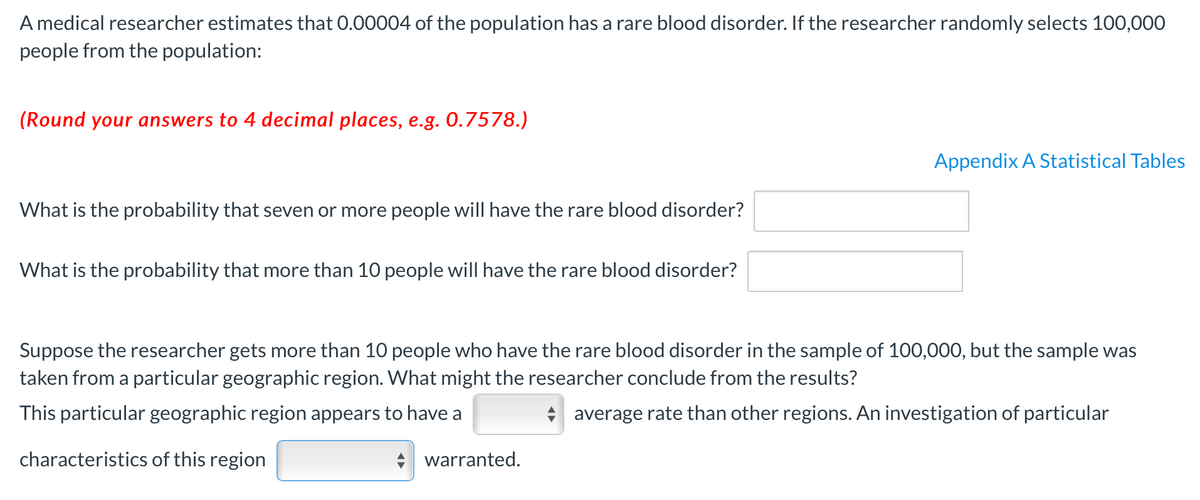A medical researcher estimates that 0.00004 of the population has a rare blood disorder. If the researcher randomly selects 100,000 people from the population: (Round your answers to 4 decimal places, e.g. 0.7578.) Appendix A Statistical Tables What is the probability that seven or more people will have the rare blood disorder? What is the probability that more than 10 people will have the rare blood disorder? Suppose the researcher gets more than 10 people who have the rare blood disorder in the sample of 100,000, but the sample was taken from a particular geographic region. What might the researcher conclude from the results? This particular geographic region appears to have a * average rate than other regions. An investigation of particular characteristics of this region * warranted.
A medical researcher estimates that 0.00004 of the population has a rare blood disorder. If the researcher randomly selects 100,000 people from the population: (Round your answers to 4 decimal places, e.g. 0.7578.) Appendix A Statistical Tables What is the probability that seven or more people will have the rare blood disorder? What is the probability that more than 10 people will have the rare blood disorder? Suppose the researcher gets more than 10 people who have the rare blood disorder in the sample of 100,000, but the sample was taken from a particular geographic region. What might the researcher conclude from the results? This particular geographic region appears to have a * average rate than other regions. An investigation of particular characteristics of this region * warranted.
Chapter8: Sequences, Series,and Probability
Section8.7: Probability
Problem 50E: Flexible Work Hours In a recent survey, people were asked whether they would prefer to work flexible...
Related questions
Question
q3
("lower/higher") are options for the first arrow ("might be/might not be") are options for the second arrow.

Transcribed Image Text:A medical researcher estimates that 0.00004 of the population has a rare blood disorder. If the researcher randomly selects 100,000
people from the population:
(Round your answers to 4 decimal places, e.g. 0.7578.)
Appendix A Statistical Tables
What is the probability that seven or more people will have the rare blood disorder?
What is the probability that more than 10 people will have the rare blood disorder?
Suppose the researcher gets more than 10 people who have the rare blood disorder in the sample of 100,000, but the sample was
taken from a particular geographic region. What might the researcher conclude from the results?
This particular geographic region appears to have a
* average rate than other regions. An investigation of particular
characteristics of this region
warranted.
Expert Solution
This question has been solved!
Explore an expertly crafted, step-by-step solution for a thorough understanding of key concepts.
Step by step
Solved in 3 steps with 1 images

Recommended textbooks for you


Holt Mcdougal Larson Pre-algebra: Student Edition…
Algebra
ISBN:
9780547587776
Author:
HOLT MCDOUGAL
Publisher:
HOLT MCDOUGAL


Holt Mcdougal Larson Pre-algebra: Student Edition…
Algebra
ISBN:
9780547587776
Author:
HOLT MCDOUGAL
Publisher:
HOLT MCDOUGAL